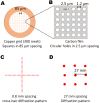Real-Time Measurement of the Liquid Amount in Cryo-Electron Microscopy Grids Using Laser Diffraction of Regular 2-D Holes of the Grids
- PMID: 32150795
- PMCID: PMC7103880
- DOI: 10.14348/molcells.2020.2238
Real-Time Measurement of the Liquid Amount in Cryo-Electron Microscopy Grids Using Laser Diffraction of Regular 2-D Holes of the Grids
Abstract
Cryo-electron microscopy (cryo-EM) is now the first choice to determine the high-resolution structures of huge protein complexes. Grids with two-dimensional arrays of holes covered with a carbon film are typically used in cryo-EM. Although semi-automatic plungers are available, notable trial-and-error is still required to obtain a suitable grid specimen. Herein, we introduce a new method to obtain thin ice specimens using real-time measurement of the liquid amounts in cryo-EM grids. The grids for cryo-EM strongly diffracted laser light, and the diffraction intensity of each spot was measurable in real-time. The measured diffraction patterns represented the states of the liquid in the holes due to the curvature of the liquid around them. Using the diffraction patterns, the optimal time point for freezing the grids for cryo-EM was obtained in real-time. This development will help researchers rapidly determine highresolution protein structures using the limited resource of cryo-EM instrument access.
Keywords: cryo electron microscopy; grid preparation; laser diffraction; real-time measurement; vitreous ice.
Conflict of interest statement
The authors have no potential conflicts of interest to disclose.
Figures






Similar articles
-
Preparation of macromolecular complexes for cryo-electron microscopy.Nat Protoc. 2007;2(12):3239-46. doi: 10.1038/nprot.2007.452. Nat Protoc. 2007. PMID: 18079724 Free PMC article.
-
Fabrication of carbon films with ∼ 500nm holes for cryo-EM with a direct detector device.J Struct Biol. 2014 Jan;185(1):42-7. doi: 10.1016/j.jsb.2013.11.002. Epub 2013 Nov 21. J Struct Biol. 2014. PMID: 24269484
-
Deformed grids for single-particle cryo-electron microscopy of specimens exhibiting a preferred orientation.J Struct Biol. 2013 Jun;182(3):255-8. doi: 10.1016/j.jsb.2013.03.005. Epub 2013 Mar 26. J Struct Biol. 2013. PMID: 23537848 Free PMC article.
-
Electron cryomicroscopy of membrane proteins: specimen preparation for two-dimensional crystals and single particles.Micron. 2011 Feb;42(2):107-16. doi: 10.1016/j.micron.2010.07.004. Epub 2010 Jul 16. Micron. 2011. PMID: 20678942 Free PMC article. Review.
-
Graphene in cryo-EM specimen optimization.Curr Opin Struct Biol. 2024 Jun;86:102823. doi: 10.1016/j.sbi.2024.102823. Epub 2024 Apr 29. Curr Opin Struct Biol. 2024. PMID: 38688075 Review.
Cited by
-
IceBreaker: Software for high-resolution single-particle cryo-EM with non-uniform ice.Structure. 2022 Apr 7;30(4):522-531.e4. doi: 10.1016/j.str.2022.01.005. Epub 2022 Feb 11. Structure. 2022. PMID: 35150604 Free PMC article.
-
Recent Developments in Correlative Super-Resolution Fluorescence Microscopy and Electron Microscopy.Mol Cells. 2022 Jan 31;45(1):41-50. doi: 10.14348/molcells.2021.5011. Mol Cells. 2022. PMID: 35114646 Free PMC article. Review.
-
Copper Oxide Spike Grids for Enhanced Solution Transfer in Cryogenic Electron Microscopy.Mol Cells. 2023 Sep 30;46(9):538-544. doi: 10.14348/molcells.2023.0058. Epub 2023 Aug 2. Mol Cells. 2023. PMID: 37528647 Free PMC article.
References
-
- Arnold S.A., Albiez S., Bieri A., Syntychaki A., Adaixo R., McLeod R.A., Goldie K.N., Stahlberg H., Braun T. Blotting-free and lossless cryo-electron microscopy grid preparation from nanoliter-sized protein samples and single-cell extracts. J. Struct. Biol. 2017;197:220–226. doi: 10.1016/j.jsb.2016.11.002. - DOI - PubMed
MeSH terms
LinkOut - more resources
Full Text Sources

